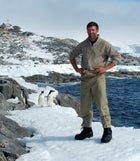Ernest Shackleton’s 800-mile open-boat crossing of the South Atlantic from Elephant Island to South Georgia, and then over the crevassed mountains of that island to the Stromness whaling station in 1916, is among the most daunting survival journeys ever made. Nearly a century later, British explorer Tim Jarvis, 46, and his crew of five men are setting out to repeat the adventure in a replica boat and hundred-year-old clothing. While Shackleton braved the sea to save his men, trapped on Elephant Island after their ship Endurance broke up in the Antarctic ice, Jarvis—also an environmental scientist—hopes to meet the challenge in part to document the effects of climate change in the Antarctic. It’s a drastic bid for adventure with potential for grim results. As the crew make their way to Elephant Island this weekend, we asked Jarvis about the journey, the old gear, and the challenges he’ll confront on water and land.
Recreating the Epic

How did the crew train for conditions you’ll meet in the Antarctic?
For the last several months we’ve been in London for sea survival training with the Royal National Lifeboat Institute—basically the Coast Guard of the U.K. We’ve been put into boats, tipped upside down, and gone through all sorts of drills on trying to conserve heat in very cold sea conditions. I tried swimming around in all the woolen clothes, seeing how long I can tread water.
How do you like wearing all the period garb?
The sea temperatures were about 12 degrees Celsius, which is 10 degrees warmer than we’ll experience down in the Antarctic. It is hard work. Flailing your arms and legs treading water is spending a lot of energy, but it’s cooling you down, because you’re getting that water flow all over your body, particularly your extremities. Realistically, unless you’ve got a life jacket and it’s fully inflated, wearing the leather boots, woolen socks, woolen thermals, woolen jumper, woolen or fur gloves, balaclava, and then the windproof layers on top—you weigh a ton. You have to kick like crazy just to stay afloat.
Shackleton and his men didn’t have life jackets. Will you be wearing any?
Good question. The answer is probably yes. I think if we didn’t have them on board at all, we would be regarded as being fools. The boat is only as good as our ability to keep the water out of the main bit in which we live. If water gets in, the thing sinks like a stone. To not at least have life jackets would have been crazy.
The problem with our boat is it has no keel. It’s an exact replica of the James Caird, which was effectively a converted rowing boat with a deck and a small sail built on. You have no capacity to turn around in that boat, so if you wanted to turn around and go into the teeth of the southwesterly wind you’ve got no chance. The wind would blow you sideways, and you’d end up in Africa, dead, four months later. It’s a sobering thought.
Is the period gear from the period itself, or is it all replica?
Some of it is exactly of the period. Things like the sextant, chronometer—all of the navigational stuff. The boat itself is new, but most of the brass fittings and fixtures are old ones, and so are all of the blocks of wood where the ropes run through pulleys and things like that. They’re all hundred-year-old reconditioned pieces of kit. The ropes are new versions of what an old hemp rope would have been, because obviously they have a limited life expectancy. The sails are brand new, but again they’re hand-stitched, made out of old canvas. So most of the technical gear is actually a hundred years old. The rest is replicated but designed precisely on the basis on the early stuff.
What sort of additional challenges do the replica gear present?
Basically it just doesn’t perform as well. I did an expedition retracing the journey of a guy called Douglas Mawson. He was a contemporary of Shackleton, Scott, and Amundsen, and they were all doing trips at exactly the same time. I replicated his expedition and used all old gear—beaver pelt gloves, reindeer skin sleeping bags, leather hobnail boots. I ate all the same rations, used an old kerosene stove, did everything the old way. The natural woolens are not bad in the wet in that they still keep you sort of warm. But they’re very heavy. And the outer layers—the Gore-Tex of a hundred years ago—are gabardine, basically cotton, and it’s hopeless.
How do you prepare for the unpredictable aspects of the journey—rogue waves, a questionable and rocky landing on the island? How much skill is involved and how much is luck?
There is a lot of luck, of course. When it comes to things like the rogue waves, there’s not a tremendous amount you can do about that. All you can do is make the boat as seaworthy as possible and practice the kind of drill we would follow in the event of a capsize. We’ve done that. We also have a kind of primitive sea anchor like Shackleton had—a fabric bag on the end of a rope which opens up like a sort of parachute. He chucked that overboard, and that slowed him down.
When it comes to landing on South Georgia, King Haakon Bay is like threading a needle. You don’t want to be in a lee shore situation where you are between the wind and the land, so if we see that that’s the predominant wind direction, we will keep tacking and tacking to try to slow our progress toward the land as best we can.
What is the procedure for a capsize or men washed overboard?
There are six of us on board and only room for four below deck at any one time. The bit below is relatively protected from the weather, but the other two are standing in a cockpit outside, and they are steering the boat and keeping one another company. In the event there’s a capsize, the four guys below will have a big pocket of air above their heads. They will be able to breathe, assuming not too much water has got in. It’s the two guys standing in the cockpit who are in trouble. We’ve made some harnesses that we can attach onto the floor of the boat and around the waist. If the boat gets tipped upside down, and you’re now hanging from the ceiling, again you might be breathing that pocket of air above you. All we do, really, is we all go to one side of the boat and wait for the next wave to tip us over, because we don’t have enough body weight to tip over a two-and-a-half-ton boat ourselves. That’s about as sophisticated as it gets.
How long can you expect to swim in two-degree Celsius water before becoming hypothermic?
There have been some very interesting tests done in the U.K. They had a military diver try to swim just wearing his boxer shorts in two-degree water, and he lasted about four minutes before he started to lose the ability to swim. It’s not as much the cold killing you. It’s the fact that the cold stops you having any coordination over your limbs, and as soon as you can’t swim, you will go under. In fact, even if you’re wearing a life jacket, with the weight of that clothing your head is going to be so close to the water with big waves. It’s obviously a bad place to be.
What’s the role of your backup vessel? Will there be daily interaction and communication?
We’re not going to have any contact with them on a daily basis, because that would be sort of cheating. We don’t get any weather from them. We don’t get any sort of warm messages from people or anything like that. They really are only there in a last-resort situation. The problem is, the very circumstances in which we’ll need them are exactly the same circumstances in which they’re not going to be able to come. A very big sea, us having capsized—you really do not want a 350-ton boat coming near you in a 60-foot swell.
It is a bit of a false sense of security you get from having a support vessel. It’s there as much to satisfy our permitting and our insurance as to effect a proper rescue. If something happens to us at night and we’re eight miles away from our support vessel, it won’t make any difference if they’re there or not.
I assume you’re optimistic or you wouldn’t be taking this journey. How confident are you of success?
If we can get to South Georgia and make a landfall at King Haakon Bay, I would give us a very good chance of making it. The chances of success change at different stages of the expedition. The crossing itself is a daunting prospect. Landing at South Georgia is almost equally daunting. I’d say there’s no more than a 50/50 of this whole thing.
Sounds like it will be a big adventure for you guys.
I think it will. Edmund Hillary described it as the greatest survival journey of all time, and I’m inclined to agree with him. The main difference between this expedition and Shackleton’s original is that he was trying to save his men from the Antarctic, and we’re trying to save Antarctica from man.
People say we’re running out of new adventures and challenges in our time, when every corner of the map is known. As an adventurer who’s repeating a century-old journey, what’s your take on that?
I don’t believe that myself. If you were around 100 years ago, you might have discovered a new river or a new animal. But the world is full of unexplored places. We don’t know a lot about the oceans, for example. The majority of the world’s peaks have not been climbed, contrary to what you might think. We’re discovering new things all the time. More to the point, it’s about challenging yourself to see if you’re capable of doing something or reaching some place. And I actually think it’s always been about that. It’s a personal journey to see what you can discover about yourself. That’s what being human is, and it manifests in lots of different spaces.


